One of the most unusual museums you'll ever visit is the Glore Psychiatric Museum in St. Joseph, Missouri. It's on the grounds of what was originally named "State Lunatic Asylum Number Two" when it was established in 1874. It's packed with full-sized replicas, interactive displays, artifacts and documents detailing how treatment of the mentally-ill--and others--evolved over the last 135 years.
The facility opened with 25 patients in 1974, then grew to over 3,000 at its peak in the 1950s as it expanded to provide treatment for tuberculosis patients, syphilitics, alcoholics, and patients with physical disabilities. The museum, located in a building on the original grounds that had once been used as the admitting ward and the clinic for hospital patients, not only details the history of treatment in this hospital but other mental health facilities from as early as the 16th century.
Exhibits almost guaranteed to give you pause include the tranquilizer chair, dousing tub, and an amazing array of objects swallowed over time by a singularly disturbed patient.
The Glore Psychiatric Museum is located at 3406 Frederick Avenue about one mile west of Interstate 29 in St. Joseph, Missouri.
Dave Donelson, author of Heart of Diamonds a romantic thriller about blood diamonds in the Congo
Saturday, December 20, 2008
The Lunacy Museum
Saturday, December 13, 2008
Blue Monster Fun

Doral Golf Resort and Spa is an oasis of luxury in the South Florida sun for golfers and their families. Guest rooms and suites are in lodges arrayed near the main clubhouse, and the Spa at Doral can only be described as palatial.
There are loads of activities for the family, too, with Camp Doral offering everything from Arts & Crafts to Volleyball. It’s next to the Blue Lagoon, where the whole family can enjoy the beach-entry pool, 125-foot waterslide, and 20 poolside cabanas with amenities. There are eight restaurants on the property, ranging from the Java Zone coffee counter to Windows On The Green, which serves fresh seafood and American cuisine with South Florida and Caribbean accents. There’s also an unheralded but not to be missed sushi bar, too.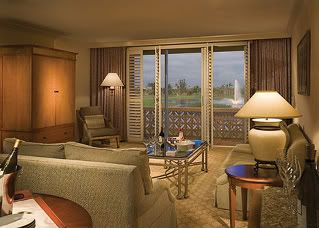 There are five courses at the resort, but the must-play track is the Blue Monster. It reminds me of a mugger in a Brooks Brothers suit--it looks harmless but it will hurt you when you least expect it. The 7,288-yard (from the tips) home of numerous PGA Tour events looks benign on paper. From the blue tees, only four of the par fours are over 400 yards and the longest is 416. The 131 slope isn’t even particularly daunting, so you stand on the first tee expecting to put some good numbers on the scorecard.
There are five courses at the resort, but the must-play track is the Blue Monster. It reminds me of a mugger in a Brooks Brothers suit--it looks harmless but it will hurt you when you least expect it. The 7,288-yard (from the tips) home of numerous PGA Tour events looks benign on paper. From the blue tees, only four of the par fours are over 400 yards and the longest is 416. The 131 slope isn’t even particularly daunting, so you stand on the first tee expecting to put some good numbers on the scorecard.
The gem of the track is the 18th hole, which played to a PGA Tour-toughest 4.625 stroke average at the 2007 WGC-CA Championship. From the mortal tees, it’s only 414 yards! But when you play it into the wind, it’s more like 474—with water on your left all the way until it cuts almost all the way across the front of the green to drown any hope you may have had of getting home in two. Your trials and tribulations aren’t over when you finally make it to the green, either—Mark Calcavecchia putted right off it into the water last year. It makes you wonder how even Tiger Woods won here three years in a row (2005-2007).
Doral Golf Resort & Spa
Miami
(800) 713-6725
www.doralresort.com
Nearest airport: Miami (15 minutes)
Golf package: $594 includes room and breakfast, one round on the Blue Monster with forecaddie for one golfer, and other amenities. Also a one-hour introductory golf clinic at no additional charge.
Dave Donelson, author of Heart of Diamonds a romantic thriller about blood diamonds in the Congo
Watch TV from anywhere in the world with the international dishnetwork deals at SatelliteDish.tv!
Saturday, December 6, 2008
One-Island Golf
 You know you’re at TPC Sawgrass when you look out your hotel room window and see the miniature island green in the lagoon. It’s not the real thing, but it might as well be, since you have just about as much chance of landing your ball there as you do on the real one at the Players Stadium Course, one of five courses at the Sawgrass Marriott Resort totaling 99 holes of fine golf in Ponte Vedre, Florida.
You know you’re at TPC Sawgrass when you look out your hotel room window and see the miniature island green in the lagoon. It’s not the real thing, but it might as well be, since you have just about as much chance of landing your ball there as you do on the real one at the Players Stadium Course, one of five courses at the Sawgrass Marriott Resort totaling 99 holes of fine golf in Ponte Vedre, Florida.
There are 18 holes on the Players Stadium Course, home of the Players Championship since 1982, but the 17th hole generates 99% of the excitement. It’s only 128 yards—the pros play about the same distance but from a slightly different angle—but the tee shot is like trying to land a ball on half of a tennis court. When the swirling winds come up, it’s more like trying to hit a ping pong table at the other end of a football field. Players lose 120,000 balls in the lake surrounding the green every year. Maybe that’s why it’s known as the most frightening hole in golf. The Marriott Sawgrass Resort provides all the amenities a tired, hungry golfer could want. There are five restaurants on the property, including the Augustine Grille, where you can treat your homesick palate to a serving of Hudson Valley foie gras before tearing into a fine steak. The 25,000 square-foot spa is the place to go after your round for a soak in the whirlpool or the Sawgrass Grand Slam, which includes a hydro and color therapy bath, a deep cleansing and exfoliation, and, for the grand finale, a full body massage.
The Marriott Sawgrass Resort provides all the amenities a tired, hungry golfer could want. There are five restaurants on the property, including the Augustine Grille, where you can treat your homesick palate to a serving of Hudson Valley foie gras before tearing into a fine steak. The 25,000 square-foot spa is the place to go after your round for a soak in the whirlpool or the Sawgrass Grand Slam, which includes a hydro and color therapy bath, a deep cleansing and exfoliation, and, for the grand finale, a full body massage.
Sawgrass Marriott Resort & Spa
Ponte Vedre Beach
800-457-4653
www.sawgrassmarriott.com
Nearest airport: Jacksonville (35 minutes)
Golf package: $469 includes room and breakfast, one round on Players Stadium Course for one golfer, forecaddie and other amenities. Note, you must be a guest at the Resort to play the Players Stadium Course.
Dave Donelson, author of Heart of Diamonds a romantic thriller about blood diamonds in the Congo
Monday, December 1, 2008
Fighting HIV/AIDS in Congo
 The spread of HIV/AIDS is among the many deplorable effects of the continuous violence in the Democratic Republic of Congo. While the country as a whole has an estimated adult HIV prevalence of 3.2%, UNAIDS reports that prevalence of the infection among women who have suffered sexual violence in areas of armed conflict may be as high as 20%.
The spread of HIV/AIDS is among the many deplorable effects of the continuous violence in the Democratic Republic of Congo. While the country as a whole has an estimated adult HIV prevalence of 3.2%, UNAIDS reports that prevalence of the infection among women who have suffered sexual violence in areas of armed conflict may be as high as 20%.
The eastern provinces have seen an astounding number of terror rapes--one every half hour, 24 hours every day--with a corresponding rise in HIV/AIDS.
Children are affected, too, both by infections through mother-to-child transmission and the loss of a parent to the disease. According to UNAIDS, 120,000 children under the age of 15 are infected with HIV.
While Congolese government efforts to fight the epidemic are not inconsiderable and the US provided $10.6 million specifically for essential HIV/AIDS programs to the DRC through USAID in fiscal 2008, getting assistance to the war zones is all but impossible. Over 1,000,000 people are homeless as a direct result of the fighting in the region, further complicating the delivery of essential medical services of all types.
While there is little we as individuals can do to stop the violence in the DRC, we can help its victims. One organization I support is Women For Women International, a leading force in helping women and their families re-establish their lives.
Dave Donelson, author of Heart of Diamonds a romantic thriller about blood diamonds in the Congo
Sunday, November 30, 2008
Nature and History of a River Town
I happened to be visiting my family in St. Joseph, Missouri, the day the new Remington Nature Center opened. The new museum on the banks of the Missouri River presents a fine look at both the flora and fauna of the area and the history of the old river town from the first Native American settlements to the early 20th century.
The museum is equally divided between the two types of exhibits, providing something to entrance just about everyone in the family. Visitors are greeted by a 10,000 year-old wooly mammoth at the front door, then meander past a collection of fossil remains found in the area. A 7,000 gallon aquarium holds fish endemic to the Missouri River flowing just a hundred yards from the front door. One of the most intriguing displays is a sand table where you can watch the tracks of various Missouri animals appear and disappear as if their ghosts are strolling across the sand before your eyes.
There's a full-scale model beaver home with exquisite detail as well as several interactive environmental displays where you can hear everything from the call of an eagle to the buzz of the honeybees that make the region their home.
A surprisingly complete history of man's impact on the area is contained in a stroll-through section that includes dioramas of Native Americans in the Mississipian period making pottery, a fur trapper's tent, and a trader's cabin modeled after the one used by Joseph Robidoux, the town's founder. Theater productions include presentations about St. Joseph's role in the California Gold Rush and the Oregon Trail. You even walk through a section of a street from the early days of the town and peer into storefronts re-created by merchants of the pioneer era.
The Remington Nature Center is located at 1502 MacArthur Drive in St. Joseph, Missouri. The easiest way to find it is to follow signs to the riverfront casino.
Dave Donelson, author of Heart of Diamonds a romantic thriller about blood diamonds in the Congo
Saturday, November 22, 2008
Make Tracks For Tampa
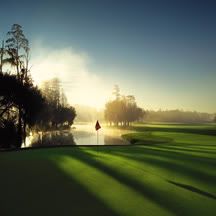 Anyone who says Florida golf is flat and water-bound hasn’t played at Innisbrook, home of four fine courses on the Gulf Coast near Tampa. Both the Copperhead, the 7,340-yard (from the tips) home of the PGA Tour’s PODS Championship, and the newly-renovated Island Course, with a tight 7,310 yards, have elevation changes as dramatic as any you’ll find at your favorite course—-and there’s nary a palm tree in sight. Instead, fairways are sharply and picturesquely defined with cedars and pines with plenty of Spanish moss to give them a Carolinas feel.
Anyone who says Florida golf is flat and water-bound hasn’t played at Innisbrook, home of four fine courses on the Gulf Coast near Tampa. Both the Copperhead, the 7,340-yard (from the tips) home of the PGA Tour’s PODS Championship, and the newly-renovated Island Course, with a tight 7,310 yards, have elevation changes as dramatic as any you’ll find at your favorite course—-and there’s nary a palm tree in sight. Instead, fairways are sharply and picturesquely defined with cedars and pines with plenty of Spanish moss to give them a Carolinas feel.
Both courses, as well as the North and South Highland tracks, have lots of water and sand, though, which keep them honest and make you earn your pars. The Island Course has all new greens and several new tees, the result of a $1.7 million renovation that started the day after resort owner Sheila Johnson closed on her purchase of the property in 2007. With tighter fairways, water on nine holes, and some dramatic doglegs, it’s actually a tougher course than the Copperhead, as reflected in the 73.5 rating/140 slope from the back (Green) tees.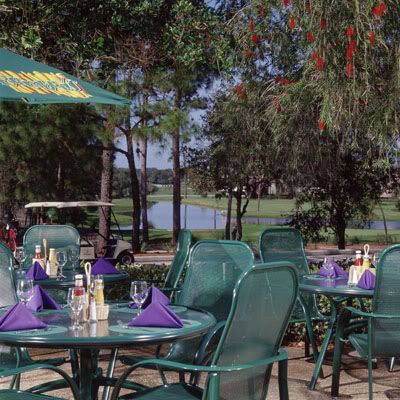 The renovation of the Island Course is the first step in Johnson’s plans to revitalize the property. The resort’s first full-service 12,000-square-foot spa is scheduled to open in 2008 along with a state-of-the-art fitness area. There is no central hotel-style lodging facility at Innisbrook—-you stay in roomy, comfortable low-rise condos scattered around the 900-acre resort—-and a remarkably responsive shuttle takes you anywhere you want to go on the property. There are four restaurants, 11 Har-tru tennis courts, a nature preserve, and six pools, including the water-park-style Loch Ness Pool.
The renovation of the Island Course is the first step in Johnson’s plans to revitalize the property. The resort’s first full-service 12,000-square-foot spa is scheduled to open in 2008 along with a state-of-the-art fitness area. There is no central hotel-style lodging facility at Innisbrook—-you stay in roomy, comfortable low-rise condos scattered around the 900-acre resort—-and a remarkably responsive shuttle takes you anywhere you want to go on the property. There are four restaurants, 11 Har-tru tennis courts, a nature preserve, and six pools, including the water-park-style Loch Ness Pool.
Innisbrook Resort and Golf Club
Tampa
(800) 456-2000
www.innisbrookgolfresort.com
Nearest airport: Tampa (30 minutes)
Golf package: $299 per person per night includes room and breakfast, one round of golf, daily golf clinic, and other amenities.
Dave Donelson, author of Heart of Diamonds a romantic thriller about blood diamonds in the Congo
Saturday, November 15, 2008
Family Champion Destination

For a family-oriented golf vaction, where else would you go but to Orlando, home of more kid-friendly attractions than anyplace on earth. You can do the whole Disney thing (and there are some fine courses in Mickey land), but a destination worth considering is one that’s sort of under the radar in Orlando—-but it shouldn’t be. It’s Championsgate, home to two world-class Greg Norman-designed courses, David Leadbetter’s Golf Academy, a magnificent Omni Resort Hotel, and just fifteen minutes away from the Magic Kingdom et al. There are multiple dining choices, too, including my favorite, David’s Club, an upscale sports bar/steakhouse.
But first things first—-golf at Championsgate. You’ll experience two completely different style courses, both of which are worth your time and attention. The International, which plays host to the Father-Son Challenge in December, carries one of the highest rating and slope of any course in Florida, a whopping 76.8/143 from the tips, which measures 7,363 yards. It’s no pushover from the blue tees, either, stretching 6,792. Norman designed a true links course, with wind-swept, treeless fairways, run-up approaches to hard, fast greens, and a plethora of pot bunkers in truly inconvenient locations.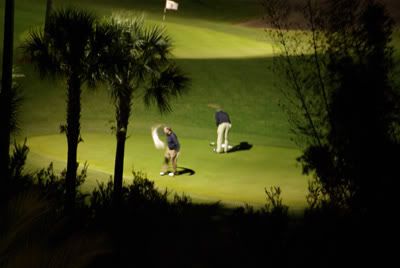 The National is a (somewhat) kinder and gentler parkland layout. It’s a little shorter at 7,128, but much, much tighter. Spanish-moss-draped trees, thick stands of palmettos, and ball-swallowing waste areas frame nearly every hole—none of which play very straight.
The National is a (somewhat) kinder and gentler parkland layout. It’s a little shorter at 7,128, but much, much tighter. Spanish-moss-draped trees, thick stands of palmettos, and ball-swallowing waste areas frame nearly every hole—none of which play very straight.
Mom doesn’t have to entertain the kids while Dad plays golf at Championsgate, either. There’s the Omni Kids Club to keep them occupied while Mom joins Dad on the links or enjoys the spa. For whole-family fun, the Omni offers the 850-ft. Lazy River tube-float, a zero-entry family activity pool, lighted tennis and basketball courts, a sand volleyball court, and a really entertaining lighted nine-hole par-three golf course, with holes ranging from 55 to 85 yards. On second thought, who needs to fight the crowds at Sea World?
Championsgate
Orlando
(888) 558-9301
www.championsgategolf.com
Nearest airport: Orlando (30 minutes)
Golf package: $367 per night (for two persons double occupancy) includes room and breakfast, and as many rounds on both courses as you can play in one day. After dark, the lighted par-three course is included, too.
Dave Donelson, author of Heart of Diamonds a romantic thriller about blood diamonds in the Congo
Saturday, November 8, 2008
Putting On The Ritz
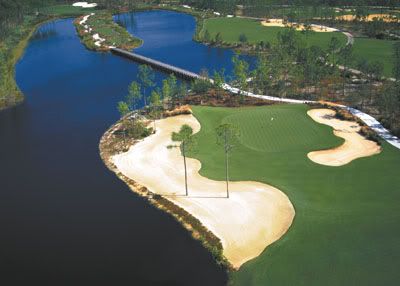 It’s hard to say which is more enjoyable at the Ritz-Carlton Golf Resort at Tiburon in Naples—-the championship-caliber golf courses or the wonderful amenities at the posh hotel. There are two sophisticated Greg Norman-designed courses, both highly playable by golfers at all skill levels, the Rick Smith Golf Academy, and a magnificently-appointed Ritz-Carlton where guests are pampered with premium-class service at every turn as well as goose-down comforters and pillows, Frette linens, marble baths, and Bulgari toiletries in the luxurious rooms.
It’s hard to say which is more enjoyable at the Ritz-Carlton Golf Resort at Tiburon in Naples—-the championship-caliber golf courses or the wonderful amenities at the posh hotel. There are two sophisticated Greg Norman-designed courses, both highly playable by golfers at all skill levels, the Rick Smith Golf Academy, and a magnificently-appointed Ritz-Carlton where guests are pampered with premium-class service at every turn as well as goose-down comforters and pillows, Frette linens, marble baths, and Bulgari toiletries in the luxurious rooms.
But golf is why I was there, and it was some of the best I've ever played in the Sunshine State (or anywhere else). The Gold Course is a 7,288-yard gem (from the tips) where they play the Merrill Lynch Shootout during golf’s silly season each December. It offers mostly wide, inviting fairways leading to generous greens, but watch out for the sprawling bunker complexes and/or water on every hole.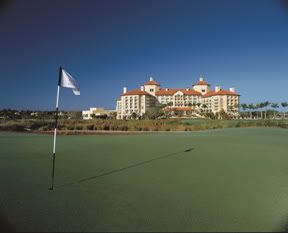 The Black Course at Tiburon may not host a professional golf event, but it’s the harder—-and better—-course in my book. At 7,005 yards it’s shorter, but the landing areas are considerably tighter. It’s also a more scenic course, with many holes framed beautifully by Spanish-moss-draped live oaks and stands of majestic pines. Even the ball-gobbling waste areas are picturesque in a Southern-Gothic kind of way. The number one handicap hole on the Black Course is the second hole, which looks quite tame on the scorecard at a straightaway 436 yards. Step onto the tee box, though, and you’ll see why it’s rated the hardest hole on the course: your drive has to thread a pine-lined chute the width of a single lane in a bowling alley to find the fairway.
The Black Course at Tiburon may not host a professional golf event, but it’s the harder—-and better—-course in my book. At 7,005 yards it’s shorter, but the landing areas are considerably tighter. It’s also a more scenic course, with many holes framed beautifully by Spanish-moss-draped live oaks and stands of majestic pines. Even the ball-gobbling waste areas are picturesque in a Southern-Gothic kind of way. The number one handicap hole on the Black Course is the second hole, which looks quite tame on the scorecard at a straightaway 436 yards. Step onto the tee box, though, and you’ll see why it’s rated the hardest hole on the course: your drive has to thread a pine-lined chute the width of a single lane in a bowling alley to find the fairway.
Then there are the accommodations at the Ritz-Carlton. Actually, there are two Ritz properties to choose from in Naples. The beach hotel is a short shuttle from Tiburon so you can catch a few rays on the sand (instead of blasting out of it with a wedge) when you’re ready for a break from golf. There’s also an expansive, exquisite spa there. The Ritz-Carlton Golf Resort has a small but opulent spa as well, and offers five restaurants, led by the signature dining experience, Lemonía, a Tuscan grill featuring contemporary Italian cuisine in Mediterranean surroundings and an excellent wine list. There’s also Sydney’s Pub at the golf club house, a more down-to-earth place where you can enjoy a cold one while you settle the day’s wagers.
Ritz-Carlton Golf Resort
Naples
239-593-2000
www.tiburongcnaples.com
Nearest airport: Ft. Myers (40 minutes)
Golf package: $949 per night (for two persons double occupancy) includes room and breakfast, and one round of golf for both or two rounds for one golfer.
Dave Donelson, author of Heart of Diamonds a romantic thriller about blood diamonds in the Congo
Tuesday, November 4, 2008
A Virtual Book Tour
I'm touring the web this month to talk about Heart of Diamonds and the situation in the Congo. Three of the early stops tell the story behind the story and how I came to write a romantic thriller about blood diamonds. You can read more at Beyond The Books, The 1st Page, and The Story Behind The Book.
Dave Donelson, author of Heart of Diamonds a romantic thriller about blood diamonds in the Congo
Saturday, September 6, 2008
Heart of Diamonds Cool Congo Read
Heart of Diamonds, my novel set in the Congo, is now officially cool.
It's actually the Cool Book Of The Day, an honor bestowed by PR guru Dan Janal. You can read Dan's scintillating interview with me at www.coolbookoftheday.com/2008/09/05/heart-of-diamonds.
Dave Donelson, author of Heart of Diamonds a romantic thriller about blood diamonds in the Congo
Wednesday, September 3, 2008
On Top Of The World At Mihingo
 You’ll feel on top of the world at Mihingo Lodge, which is perched on a large rocky outcropping with expansive views of Lake Mburo National Park. From this vantage point, sunrise through the morning mists over Lake Kacheera and sunset behind the hills framing Lake Mburo are amazingly spectacular.
You’ll feel on top of the world at Mihingo Lodge, which is perched on a large rocky outcropping with expansive views of Lake Mburo National Park. From this vantage point, sunrise through the morning mists over Lake Kacheera and sunset behind the hills framing Lake Mburo are amazingly spectacular.
Every suite has expansive views, as well as a four poster bed built from local olive trees. The suites are actually spacious tents built on wooden platforms on stilts and covered by a thatched roof. The bathroom has a shower built from rock and positioned so you can watch the impalas, zebras, eland, topi, waterbuck, and other wildlife visiting the watering hole at the base of the hill. 
The main lodge is a fascinating thatched affair built of rocks, weathered wood found on the land, and native grasses. It’s laid out with several intimate seating areas where you can enjoy private moments, a small bar for the dozen or so guests, and an open-air dining room. On a terrace just below, an infinity swimming pool stretches out from the rocks and seems to disappear into the vast landscape.
The nightly rate is $210 per person inclusive of all meals, drinks, and laundry. Guided game drives, walks, and boat trips can be arranged. The lodge is about four hours from Entebbe International Airport.
Dave Donelson, author of Heart of Diamonds a romantic thriller about blood diamonds in the Congo
Wednesday, August 27, 2008
Lazy Days at Ishasha
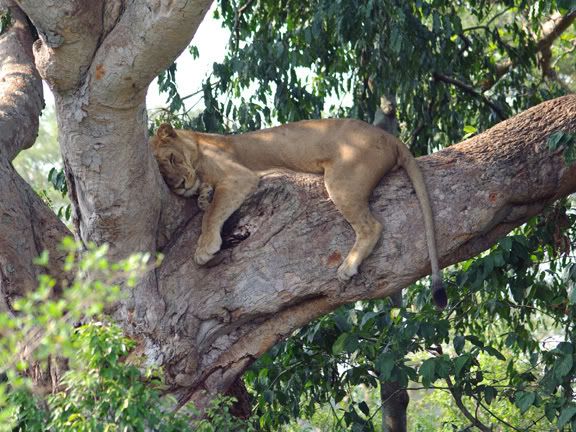
You know cats climb trees, but did you know there are some lions who actually live in them? One of two places in the world where you can see them is at Ishasha in Queen Elizabeth National Park. Ishasha Camp is a rustic destination but the sight of those 400-pound felines draped over the spreading branches of a fig tree makes a little “roughing it” completely worthwhile.
Ishasha Camp offers ten East African Meru style tents on the banks of the Ntungwe river. These aren’t pup tents, though. Each has a private bath and dressing area, eco-friendly toilet, and hot water “bush” shower, which isn’t as primitive as it sounds. Twin beds are standard, but the staff will gladly put two together at your request.
The nightly rate is $190 per person inclusive of all meals, drinks, and laundry. Guided game drives and community visits can be arranged. Ishasha Airstrip, served by charter flights, is just a few minutes from camp.
Dave Donelson, author of Heart of Diamonds a romantic thriller about blood diamonds in the Congo
Wednesday, August 20, 2008
Bwindi Impenetrable Forest Gorilla Trek
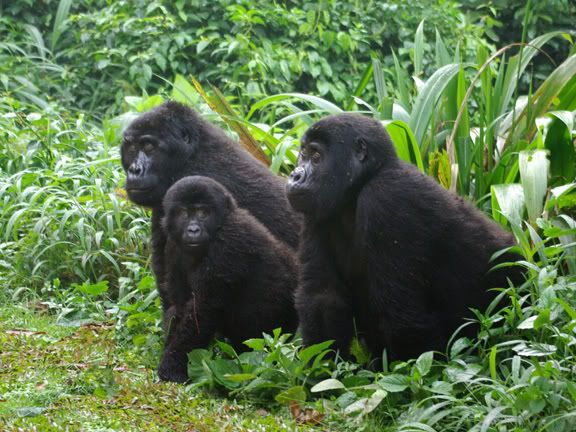 Trekking among the 320 endangered mountain gorillas in Bwindi Impenetrable Forest (a World Heritage Site) is not easy, it’s certainly not cheap, but it will provide memories for a lifetime. Looking into the gentle eyes of a gorilla mother nursing her baby is a transcendental experience.
Trekking among the 320 endangered mountain gorillas in Bwindi Impenetrable Forest (a World Heritage Site) is not easy, it’s certainly not cheap, but it will provide memories for a lifetime. Looking into the gentle eyes of a gorilla mother nursing her baby is a transcendental experience.
Mountain gorilla treks can take up to six hours and involve strenuous hikes up muddy mountainsides through the rainforest—-or they can be a ten minute stroll up the road, depending on where the gorillas decide to spend the day. You go in a small group (no more than The nightly rate is $322 per person inclusive of all meals, drinks, and laundry. Guide fees and permits are not included. Kayonza airstrip, served by charter flights, is forty minutes away.six visitors) accompanied by rangers and porters and are allowed to spend an hour with the people-habituated gorillas once the scout guides find them. The permit costs $500 per person per day (it’s suggested you book two days since there is no guarantee you’ll find the gorillas!), but they sell out months in advance, so make your reservation early. Your fees are what make preservation of the nearly-extinct gorillas possible, which helps ease the blow to your bank account. You can also hire a guide to take you through a nearby village to visit a traditional healer who sells a herbal version of Viagra, a woman who makes banana gin (you gotta try it to believe it), and a settlement of the Batwa, commonly known as pygmies, who put on a cheerful exhibition of traditional songs and dances. They’re delighted when you join in the fun.
You can also hire a guide to take you through a nearby village to visit a traditional healer who sells a herbal version of Viagra, a woman who makes banana gin (you gotta try it to believe it), and a settlement of the Batwa, commonly known as pygmies, who put on a cheerful exhibition of traditional songs and dances. They’re delighted when you join in the fun.
Gorilla Forest Camp makes an excellent base for your experience. Your cabin (one of only eight on the property) is a secluded permanent tent with a huge attached bathroom and 24-hour valet service. Honeymooners receive special treatment like hot bubble baths strewn with flower petals and surrounded by scented candles waiting for them when they come back from their day tracking gorillas in the mountains. A special honeymoon surprise (don’t tell anybody!) is dinner for two cooked on site in a secret location by a dedicated chef and served by a personal butler.
Dave Donelson, author of Heart of Diamonds a romantic thriller about blood diamonds in the Congo
Travel everywhere from your living room with a dish network dvr receiver from SatelliteDish.tv, where you can find satellite tv reviews of hdtv receiver dvrs, satellite hd receivers and even a directv satellite receiver!
Monday, August 11, 2008
Grace Epitomized at Nkwali
Giraffes may be the most graceful animals on earth. As you watch them amble through the bush looking for tasty leaves high in the acacia trees, it’s easy to forget your cares and let their serenity carry you away. You'll see plenty of them at Nkwali Camp, which is directly across the river from South Luangwa National Park, home to the unique Thorneycroft’s giraffe. A typical day at Nkwali begins with a light breakfast served around the campfire, followed by a game walk or drive with a guide and armed ranger among a huge population of elephant, buffalo, lion, impala, bushbuck, eland, and more bird species than you can count. Then you’ll take a mid-morning break for tea, coffee, and cake toted along by your porter, perhaps while you watch the hippos cavort in a scenic lagoon. You’ll return to camp for lunch, a swim, and a siesta before afternoon tea, then back to the trail for an evening drive to see wildlife you’ll only find at night. I’ll always remember my first leopard sighting—she had paused to drink from the river under a full moon and was reflected perfectly in the black water.
A typical day at Nkwali begins with a light breakfast served around the campfire, followed by a game walk or drive with a guide and armed ranger among a huge population of elephant, buffalo, lion, impala, bushbuck, eland, and more bird species than you can count. Then you’ll take a mid-morning break for tea, coffee, and cake toted along by your porter, perhaps while you watch the hippos cavort in a scenic lagoon. You’ll return to camp for lunch, a swim, and a siesta before afternoon tea, then back to the trail for an evening drive to see wildlife you’ll only find at night. I’ll always remember my first leopard sighting—she had paused to drink from the river under a full moon and was reflected perfectly in the black water.
Nkwali Camp only accommodates 12 guests. The cool, spacious chalets are woven bamboo and thatch. For a real treat, ask for the honeymoon suite, which is extra large with a sitting room, bath, and king bed. The bar at the camp is built around an enormous ebony tree and the separate dining area overlooks a small lagoon that often attracts elephants and bushbuck. Visits to a nearby village and school can also be arranged.
The nightly rate is $550 per person inclusive of all meals, drinks, laundry, activities, and airport transfers. Mfuwe Airport is 45 minutes away.
Dave Donelson, author of Heart of Diamonds a romantic thriller about blood diamonds in the Congo
Wednesday, July 16, 2008
Camping In The Bush

Kakuli Bush Camp, at the confluence of the Luwi and Luangwa rivers in South Luangwa National Park, looks and feels like an “old time” safari camp where Meryl Streep and Robert Redford might step onto the set at any minute to film a scene for Out of Africa. Norman Carr, who founded Norman Carr Safaris, the operator of the camp, was a legendary big-game hunter before he became an ardent conservationist.
His spirit lives on in the most popular activity at the camp, tracking big game on foot accompanied by expert guides and scouts. There’s nothing quite so thrilling as photographing a pair of young lions with nothing between you and them except twenty yards of grass. Zambia is one of the few places where that’s allowed—most countries require safari operators to keep guests inside vehicles.
Many of the spacious tents at Kakuli are surrounded by evergreen trichelia trees for extra privacy from the other five chalets. You'll also have a deck, attached open air bathroom, and an emperor size bed. Huge ancient acacia trees-—with seed pods that are favorite snacks for the elephants—-shade several tents. If you are honeymooning, let them know in advance; the staff greets honeymooners with a special traditional song of congratulation and goes out of their way to arrange surprises like sparkling wine “sundowners” or a romantic bush dinner on the riverbank where hundreds if not thousands of hippos congregate in the moonlight.
The nightly rate for two is $570 per person inclusive of all meals, drinks, laundry, activities, and airport transfers. Mfwue Airport is about two hours away.
Dave Donelson, author of Heart of Diamonds a romantic thriller about blood diamonds in the Congo
Friday, June 13, 2008
Safari Luxury at Siankaba
 The Islands of Siankaba is the perfect spot to begin or end a trip to Zambia, Botswana, or Namibia—or a place to stay the entire time. It’s a riverine wonderland located on two untouched islands on the Zambezi River between Victoria Falls and Chobe National Park about 45 minutes from Livingstone, Zambia
The Islands of Siankaba is the perfect spot to begin or end a trip to Zambia, Botswana, or Namibia—or a place to stay the entire time. It’s a riverine wonderland located on two untouched islands on the Zambezi River between Victoria Falls and Chobe National Park about 45 minutes from Livingstone, Zambia
Luxury is the byword at Siankaba. The secluded chalets are two-story teak and canvas affairs that sit like a tree houses on eco-friendly platforms raised above the island itself. Inside are custom furnishings made from renewable native woods, king-size canopy beds, and bath suites with Victorian fixtures that include a claw-foot tub large enough for two. You will enjoy a garden deck, sun lounge, and a private dining area as well as a library and games compendium. You’ll also find your chalet equipped with sandalwood amenities, full mini bar, bathrobes & slippers, champagne, roses, bubble baths, and floating candles. For honeymooners, a complimentary private massage is included, too.
and canvas affairs that sit like a tree houses on eco-friendly platforms raised above the island itself. Inside are custom furnishings made from renewable native woods, king-size canopy beds, and bath suites with Victorian fixtures that include a claw-foot tub large enough for two. You will enjoy a garden deck, sun lounge, and a private dining area as well as a library and games compendium. You’ll also find your chalet equipped with sandalwood amenities, full mini bar, bathrobes & slippers, champagne, roses, bubble baths, and floating candles. For honeymooners, a complimentary private massage is included, too. As comfy as it is, you won’t spend your entire stay in your chalet. At your request, a guide from the lodge will drive you to the town of Livingstone and Victoria Falls, where you can see the sites or get an adrenaline rush bungee jumping, whitewater rafting, river boarding, jet boating, or gorge swinging. Or stay closer to Siankaba and take a guided tour of the tiny thatched-roofed village itself and the nearby school. Visiting the Zambians who live there was the absolute highlight of our first trip to Africa and several scenes from our visit became part of my novel, Heart of Diamonds.
As comfy as it is, you won’t spend your entire stay in your chalet. At your request, a guide from the lodge will drive you to the town of Livingstone and Victoria Falls, where you can see the sites or get an adrenaline rush bungee jumping, whitewater rafting, river boarding, jet boating, or gorge swinging. Or stay closer to Siankaba and take a guided tour of the tiny thatched-roofed village itself and the nearby school. Visiting the Zambians who live there was the absolute highlight of our first trip to Africa and several scenes from our visit became part of my novel, Heart of Diamonds.
At the end of the day, enjoy a sunset cruise on the Zambezi with the other guests (the lodge only accommodates 14 total) or a private outing for just the two of you in a makoro—a dugout canoe—paddled by one of the lodge guides. After “sundowners,” the civilized safari version of cocktail hour where you watch the most beautiful sunsets in the world as you sip your libation of choice, you’ll go back to the lodge for either an intimate candlelit dinner for two or a social family-style meal with the other guests.
After days of tramping the Luangwa bush in Zambia or the Okovongo Delta in Botswana, Siankaba is a welcome respite.
Dave Donelson, author of Heart of Diamonds a romantic thriller about blood diamonds in the Congo
Wednesday, May 28, 2008
The Hippo Song
Every safari guide in Africa knows this song and sings it at the drop of an impala poop. We first heard it in Zambia. This rendition is performed by guide Jacob Shawa at Nkwali Lodge on the Luangwa River.
Mud, mud, glorious mudThe British musical comedy duo Michael Flanders and Donald Swann introduced “The Hippopotamus Song” in their musical review At The Drop Of A Hat in 1956.
Nothing quite like it for cooling the blood.
So follow me, follow
Down to the hollow
And let us wallow in glorious mud.
Dave Donelson, author of Heart of Diamonds a romantic thriller about blood diamonds in the Congo
Monday, May 12, 2008
Sleeping Over With Arnold Palmer
A visit to Arnold Palmer's Bay Hill Club and Lodge in Orlando is like sleeping in Arnie’s spare bedroom and sneaking out to play a few holes before the members show up at his home course. That’s because it is Arnie’s spare bedroom and his home course. In 1976, Arnold Palmer purchased the lodge and it has been the winter home of the Palmer family ever since. As one of my golf buddies said, “I felt like Arnie was going to come walking down the hallway in his bathrobe.” It’s not a mega-course complex, but it’s a wonderful golf experience.
There are twenty-seven holes of fine golf here. They are the Champion and Challenger nines, which together make up the course for the Bay Hill Invitational, rated the tenth toughest on the PGA Tour, and the Charger course, with five dog-legs and water in play on four holes. For Florida golf, there are a surprising number of elevation changes and tree-lined fairways. There are also plenty of greenside mounds and bunkers that dictate long iron shots that must come in high in order to hold.
Both courses are private and you must be a guest of a member or staying at the resort's lodge to play them. It’s members-only on Saturday morning, too, so you’ll need a tee time at one of the other 168 courses in Orlando, if you want to play golf every waking moment, as you should on a buddy trip. The Lodge is small and homey, with 64 comfortable rooms, a fireside club-style bar, and an informal dining room where you can enjoy a sumptuous buffet three times a day or order from the down-to-earth American-fare menu.
Dave Donelson, author of Heart of Diamonds a romantic thriller about blood diamonds in the Congo
Saturday, May 3, 2008
Tic Tac Sundowners
One safari tradition polished to a high gloss of grace and gentility in Zambia is sundowners, that magical ceremony where everyone stops whatever they're doing at the end of the day, fixes a drink, and watches the sun go down.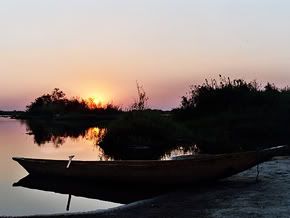 It's fun in a group, because everyone chats and swaps tales of the day's adventures until just that special moment when the sun dips below the horizon. That's also when the sky typically glows red, particularly during the dry season when the air near the ground is lightly hazed with reflective dust. On a really good night, you'll see the moon rising as the sun disappears.
It's fun in a group, because everyone chats and swaps tales of the day's adventures until just that special moment when the sun dips below the horizon. That's also when the sky typically glows red, particularly during the dry season when the air near the ground is lightly hazed with reflective dust. On a really good night, you'll see the moon rising as the sun disappears.
As you can imagine, sundowners can also be a very romantic event when there are just two of you. It's a quiet time for special wishes and quiet reflection.
Or it can be a light-hearted mini-party. One of my most memorable moments in Zambia was near the end of a trip when my wife and I had been paddled out to an island in the Zambezi by our guide Victor in a makoro, or dugout canoe. We got there a little early, so we taught Victor to play tic-tac-toe in the sand while we waited for the sun to go down. By the time we left, he was definitely more than holding his own.
What makes having sundowners such a special ceremony is that it doesn't last much more than a few minutes--usually just long enough to have one drink and a moment of contemplation with boon companions.
Dave Donelson, author of Heart of Diamonds a romantic thriller about blood diamonds in the Congo
Tuesday, April 22, 2008
"Old Africa" Charm
In the mood to try the “Old Africa” lifestyle? You'll find it at Ndali Lodge in the Bunyaruguru crater lake region of Western Uganda. It’s an intimate family-run place full of small pleasures and the atmosphere of the way things used to be.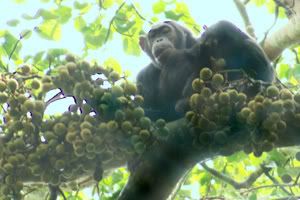
The lodge sits in a spectacular location on the rim of an extinct volcano that filled with water to become Lake Nyinambuga. It is surrounded by villages of the Toro people and tea plantations, some still owned by the family of the builder of the lodge, Mark Price, whose father settled in the region in the 1920’s.
There is a main thatched lodge with bar and sitting room, reception area and dining room flanked by cottages built of local stone and thatch. The cottages face west to offer a panoramic view of the Rwenzori Mountains, also known as the Mountains of the Moon.
The lodge has no electricity, but the dining room and cottages are lit with candles and lanterns, giving it a wonderfully romantic “Old Africa” air. Fruit bats swoop through the open passage ways and in and out among the rafters in the dining room. Three rather fat and spoiled dogs wander in and out and sleep on the cottage verandas, lending a homey touch to your stay.
Ndali Lodge provides guides for walks around the 1000 acre farm and local banana plantations, coffee terraces, plots of cassava, groundnuts, sorghum and millet. You can also visit the Mahoma Waterfall. Below the lodge is a sturdy jetty set in a secluded spot on the crater lake that’s frequented by five different species of kingfisher.
Kibale Forest National park, home of what’s claimed to be the largest concentration of chimpanzees in Africa, as well as a bewildering variety of other primates, birds and butterflies is about 45 minutes away. Also close by is the Bigodi wetland sanctuary, a community-based conservation project. Ndali is an ideal stopping off place between Queen Elizabeth National Park and Murchison Falls National Park.
Dave Donelson, author of Heart of Diamonds a romantic thriller about blood diamonds in the Congo
Thursday, April 3, 2008
Home For Me - Great Destination For You
I've lived in Westchester County just north of New York City for almost thirty years now, but I'm still amazed at the sheer number of attractions that make this not only a great place to live but to visit as well.
The arts, the architecture and, above all, the history of Westchester delight visitors of all ages. New York State celebrates its 400th birthday in 2009, but among the historic places you won’t want to miss right now are the many American Revolution sites in Westchester. George Washington didn’t just sleep here, he fought a major battle in White Plains! Saint Paul’s Church National Historic Site in Mount Vernon served as a hospital during the Revolutionary War. There's Thomas Payne's Home and several other great places to visit while you're contemplating the formation of our country. For a quiet moment of reflection, see the Gold Star Mothers monument in Yonkers.
Westchester offers an unparalleled variety of experiences. Within ten minutes, you can go from the bustling skyscrapers of downtown White Plains to the serene forested banks of Cranberry Lake Preserve, driving past historic Kensico Dam and the inspiring 9/11 memorial, “The Rising,” along the way. You’ll never exhaust Westchester’s many possibilities. For a wealth of information, visit westchestertourism.com.
From world-class museums to world-renowned golf courses (Winged Foot sound familiar?), Westchester offers something for everyone. There’s history, nature, thrilling attractions, art, music, fine dining, shopping…the things to do, places to go and experiences to enjoy in Westchester are endless.
Dave Donelson, author of Heart of Diamonds a romantic thriller about blood diamonds in the Congo
Monday, March 31, 2008
Travel Reading Strategy
One of the most important gear decisions I have to make when I'm on the road is what to read. That's especially true when it's a long trip and even more so when weight comes into play. On my trips to Africa to research Heart of Diamonds, I adopted a three-step approach to this important decision.
First was what to read on the flights from New York. My criteria were simple: it had to be paperback mass market fiction that I could enjoyably read off and on for 24 hours, then leave somewhere like an airport waiting room for someone else to enjoy when I was finished. A James Patterson thriller is almost always perfect.
For the return flight, I counted on buying something equally pleasurable somewhere along the way. With luck, I'd find an author published overseas that I wouldn't normally read at home. When I finished it, I donated it to my local library for their fund-raising book sale.
In-country was tougher. I typically read two or three books a week at home, but I sure didn't want to carry a half dozen tomes around the bush. The solution was Shakespeare. I bought a paperback edition of four tragedies, MacBeth, Hamlet, Lear, and Othello. It was a great choice because I could read and re-read them and find something new every time.
Besides, "A drum! A drum! MacBeth doth come!" provided excellent escape from a day filled with the wonders of Africa.
Dave Donelson, author of Heart of Diamonds a romantic thriller about blood diamonds in the Congo
Saturday, March 29, 2008
Toe Jam Juice
What's the first thing you're told when visiting a new country? Don't drink the water! Good advice, but sometimes you get lost in the moment. I forgot that basic tenet of travel during a walk through a village near Uganda’s Bwindi Impenetrable Forest. But at least I lived to tell the tale.
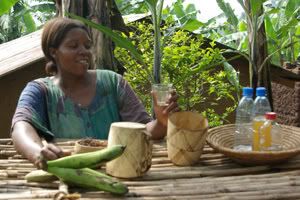 We were visiting a local beverage maker—what we would call a moonshiner in Missouri where I grew up. She said the process begins by making banana juice in a big hollowed-out tree trunk laid on its side like a canoe. The juice maker takes off his shoes and walks on the bananas like someone stomping grapes for wine.
We were visiting a local beverage maker—what we would call a moonshiner in Missouri where I grew up. She said the process begins by making banana juice in a big hollowed-out tree trunk laid on its side like a canoe. The juice maker takes off his shoes and walks on the bananas like someone stomping grapes for wine.
The juice can be drunk as is, but most of it is poured into leaf-lined pits and allowed to ferment for a few days. The resulting banana wine is quite popular. The really good stuff, though, is the banana gin, which is made by distilling the wine in wood-fired stills made from 55-gallon drums and copper tubing. Some technology just can’t be improved.
After the short lecture, our hostess grandly offered samples of all three beverages. I’m a teetotaler, so I stuck with the banana juice, which was quite flavorful. A couple of my friends tried the stronger concoction and pronounced it delicious.
Quite honestly, it wasn’t until I was telling the tale later that I realized how we had broken the first rule of travel: drink only bottled beverages! I guess the banana-stomper responsible for my glass must have had very clean feet.
Dave Donelson, author of Heart of Diamonds a romantic thriller about blood diamonds in the Congo
Sunday, March 23, 2008
Victoria Falls Through Livingstone's Eyes
“You can walk in that direction for 200 kilometers and not see another human being,” said Simon Wilde, pointing north into Zambia from the Zambezi River. The former safari guide was telling me about the countryside where David Livingstone first saw Victoria Falls in 1855, and how little it has changed since.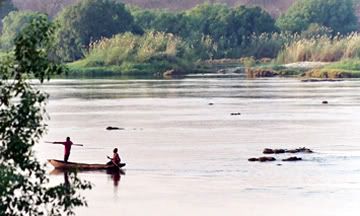 The wide Zambezi is laced with rapids and dotted with islands big and small. It is home to crocodiles, surprisingly aggressive hippos, vicious tiger fish, and hundreds of flamboyant birds, not to mention native fishermen who still ply the mighty stream in makoros, dugout canoes identical to those their ancestors used. In the villages that dot the riverbanks, men still purchase brides for three cows and a little cash and build their homes with mopane poles, mud from termite mounds, and thatch roofs. Political boundaries exist now, but otherwise it hasn’t changed much since Livingstone made his journey more than 150 years ago.
The wide Zambezi is laced with rapids and dotted with islands big and small. It is home to crocodiles, surprisingly aggressive hippos, vicious tiger fish, and hundreds of flamboyant birds, not to mention native fishermen who still ply the mighty stream in makoros, dugout canoes identical to those their ancestors used. In the villages that dot the riverbanks, men still purchase brides for three cows and a little cash and build their homes with mopane poles, mud from termite mounds, and thatch roofs. Political boundaries exist now, but otherwise it hasn’t changed much since Livingstone made his journey more than 150 years ago.
November is barely the beginning of the rainy season in Zambia, so temperatures can reach 40 degrees Celsius (104 F) and the river is still low following the dry months of September and October. Livingstone first came at that time of year, so he and his party paddled through a sluggish four kph current on the Zambezi and navigated around heavy turbulence and exposed rocks in the rapids over the 117 kilometers (72 miles) of the journey.
Dave Donelson, author of Heart of Diamonds a romantic thriller about blood diamonds in the Congo
Thursday, March 20, 2008
My First Plane Flight
Travel is an affliction of mine--one I’ve been fortunate to be able to indulge one way or another for many years now. As a TV executive, a journalist, a consultant, and many times as just a tourist, I’ve visited 48 of the 50 states, and five of the seven continents--so far. I really indulged myself with two trips to Africa researching my novel Heart of Diamonds. I still literally keep an overnight bag packed and ready to go just in case the opportunity arises.
I remember the first time I got on a jet plane. I was a junior in high school and had won a speech contest--the VFW’s Voice of Democracy--for the state of Missouri. That won me a $500 savings bond and a trip to Washington, DC to compete in the national tournament (which I didn’t win). Believe me, my friends, that was heady stuff for a 15-year-old who had never been further away from home than Topeka. I was traveling on my own, too, since my parents couldn't afford to come along and the organization only paid for one plane ticket.
I still have the pictures (somewhere) I took from the tiny window of that 707. If you’re an old folkie, you may remember the Boeing 707 as the plane Gordon Lightfoot sang about in "Early Morning Rain" and Peter, Paul, and Mary in "Leaving on a Jet Plane." In addition to pictures of the monuments and sites I saw, I have one of me shaking hands with Lyndon Johnson, who was President at the time and hadn’t yet announced he wasn’t running for re-election. We stayed in the Shoreham Hotel across the street from another Washington building that made the news a few years later--the Watergate.
I’m starting to sound like Forest Gump, so perhaps its time to bring it to a close.
Dave Donelson, author of Heart of Diamonds a romantic thriller about blood diamonds in the Congo
Tuesday, March 18, 2008
Carved Creatures of Oxaca

Fire-breathing crocodiles and flying giraffes roam folk art museums and shops around the world. They are alebrijes—hand-carved wooden figures from the Mexican state of Oaxaca.
Zapotec and Mixtec Indians have been carving in the region for at least 2500 years. Their intricate bas relief work can be seen in the ruins of Monte Alban, the ancient city sitting on a mountaintop overlooking the valley. Their descendants live in villages specializing in crafts like weaving, pottery, and metalwork as well as woodcarving.
The best-known carvers work in Arrazola, San Martin Tilcajete, and La Union Trejalapan, which are villages a few dusty miles from the city of Oaxaca. In the last thirty years, almost 100 of the approximately 500 families in Arrazola alone have turned from subsistence farming to take up the craft.
Just as on a family farm, everyone has a role in the enterprise. Traditionally, the men carve while the women and older children sand and paint. The younger children recruit customers from among the tourists and collectors drawn by the remarkable array of unique figures, masks, and furniture.
Subjects range from native creatures like armadillos, coyotes, and lizards to barnyard animals and birds. The carvers have responded to customer requests, too, by adding animals never seen in Mexico like polar bears and giraffes. Imaginary creatures—dragons, mermaids, space aliens, and many beyond simple names—compliment the typical carver’s repertoire.
Many carvers produce both real and fanciful human figures as well. Nativities and angels compete for shelf space with drunken devils and reveling skeletons, which are used in village scenes showing Day of the Dead celebrations.
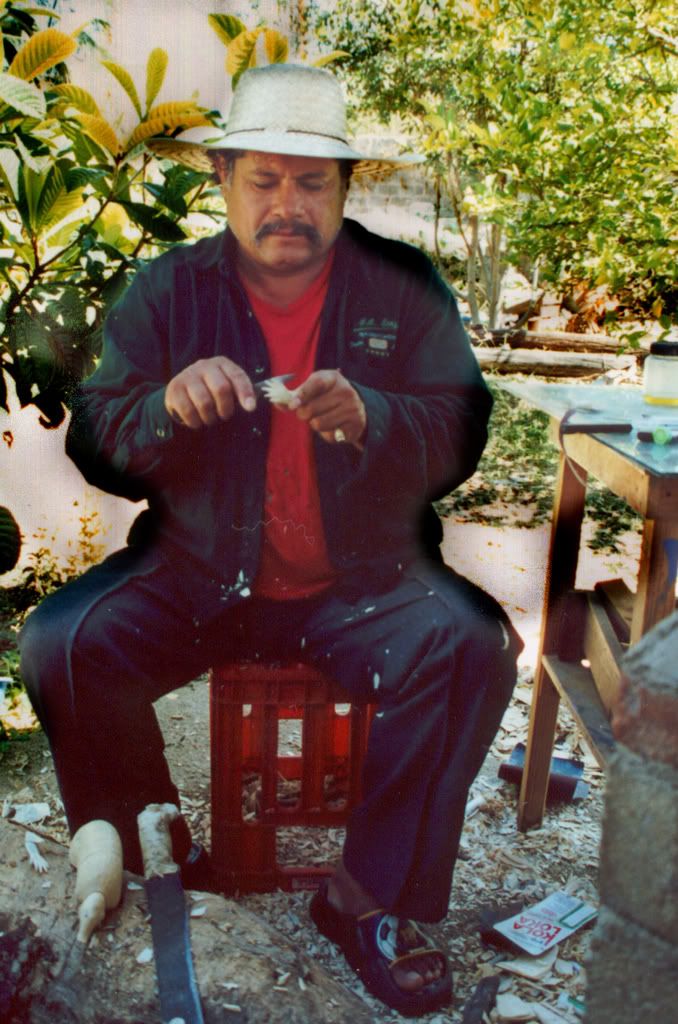 Pieces range from two-inch armadillos to six-foot wooden skeletons. Styles can be primitive and rough or smooth, round, and flowing. Their appeal comes from both the carving and the painting, both accomplished using simple hand tools and finishes. The family workshop is often a shady tree in the backyard. The carver’s “tool box” holds a machete, pocket knife, a few kitchen knives, and maybe a gouge or chisel.
Pieces range from two-inch armadillos to six-foot wooden skeletons. Styles can be primitive and rough or smooth, round, and flowing. Their appeal comes from both the carving and the painting, both accomplished using simple hand tools and finishes. The family workshop is often a shady tree in the backyard. The carver’s “tool box” holds a machete, pocket knife, a few kitchen knives, and maybe a gouge or chisel.
Most of the wood comes from the copal tree, which once grew on the hillsides surrounding the villages. The local trees were victims of the craft industry’s success, though, and have mostly disappeared. The few remaining trees are protected by environmental regulations and stiff fines are levied against poachers. Now copal is purchased from sellers who harvest it from the nearby Sierra Madre mountains.
Copal resembles basswood in density, grain, and workability. The carver, unlike a furniture maker, looks for curving, twisted branches to make pieces like spiral-tailed lizards and sinuous cats. Very little of the tree goes unused. The carver adds features using found materials like goat (or human) hair, cactus spines, splinters of wood, and fibers from maguey leaves.
The figures may be fanciful, but the carving is pretty straightforward. Once the carver visualizes the shape, he roughs it out with a machete. Final form and detailing are done by knife and the piece is left to dry for a day or so in the sun. If the shape of the branch require it, appendages like legs and wings are glued in place. These are also sometimes inserted loose into holes so the buyer can more safely pack and ship them.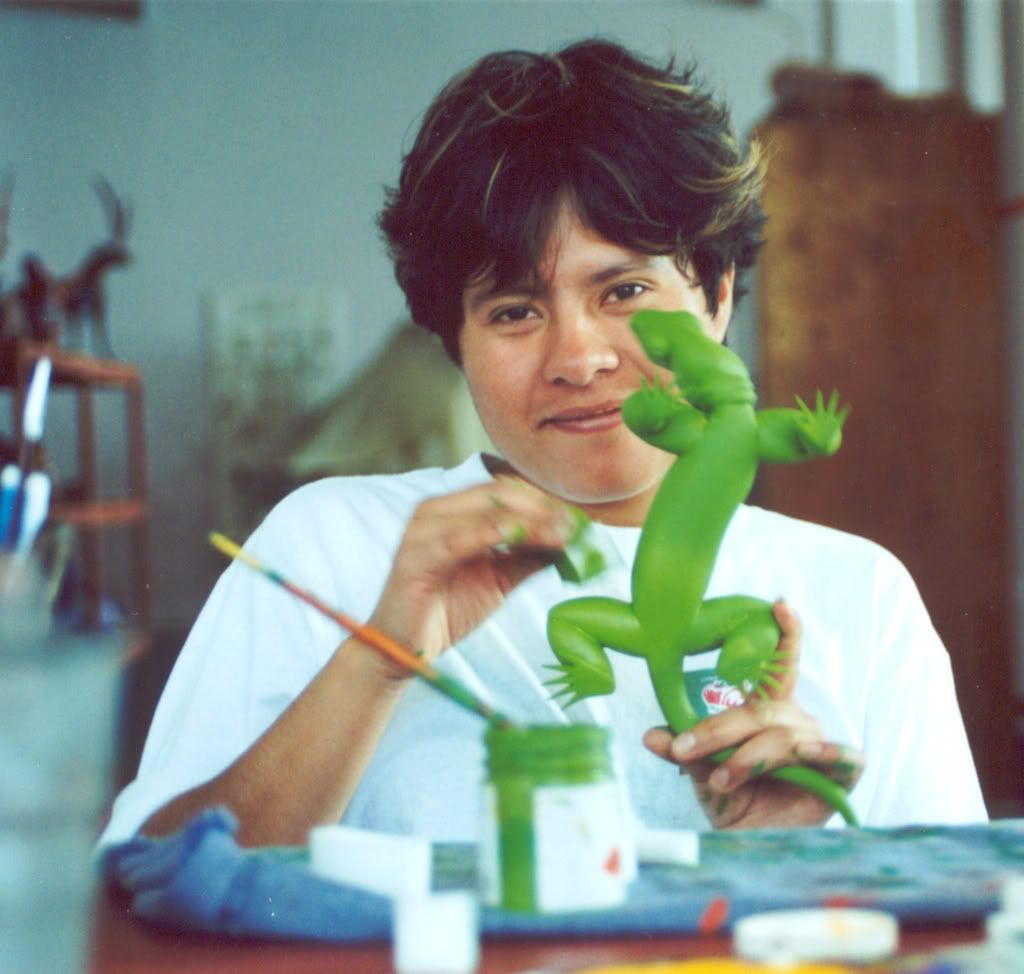
The pieces are sanded and a base coat or sealer is applied. Then the painter adds the remarkable patterns that distinguish the genre. Most of them use standard acrylic craft paints, although some of the more traditional apply aniline dyes which penetrate the wood and produce deeper, almost fluorescent, colors but fade over time. Either way, the painters have a bright palette of primary and complementary colors that they use to the fullest.
Brushes are only one of the many applicators used. The painter often chooses a sponge for base-coating because it’s cheaper and more efficient. Thorns of the mescal cactus or sharpened carving scraps make tiny dots, patterns, and other details.
The painting adds a super-normal dimension to the figures. A pointillist rabbit may coat the back of a howling coyote. Tiny strawberries and grapes may decorate an armadillo. Scales the size of the “o” in “dragon” and multi-colored dots the size of the period at the end of this sentence may cover a foot-tall bird. The variety and novelty of decoration show no boundaries.
Making fun figures like these doesn’t require a great deal of technical woodworking knowledge. More important are the qualities of the Oaxacan carver: patience, imagination and the instinct to unite art and craft.
Dave Donelson, author of Heart of Diamonds a romantic thriller about blood diamonds in the Congo
Sunday, March 16, 2008
Building A Mud House
One of the best places I visited in Zambia was the village of Siankaba on the Zambezi River. While there, I got to know “Doctor,” a guide who proudly showed me the new home he was building. Many of the details he explained found their way into my novel, Heart of Diamonds.
In Siankaba, just as where I live in New York, no project begins without a building permit issued by the appropriate authorities. Before Doctor could build his new home, he had to get permission from the village headman since all land belongs to the village. Doctor’s old house, by the way, won’t be sold. It will belong to the next person who needs a home as adjudged by the headman.
Once the site is approved, it is cleared and leveled, then holes where the walls will be are dug about a foot deep and two feet apart. They will hold upright studs of straight mopane logs about four inches thick and perhaps eight feet long.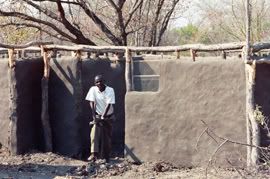 They’re held in the foundation holes with tamped earth, not cement.
They’re held in the foundation holes with tamped earth, not cement.
Headers of similar size longs are lashed to the top of the studs. Thin sticks and reeds are woven through the studs, with holes left for doors and windows. Along with the headers, they provide stiffness to the framework. They also serve as lath to hold the mud which comes next.
The mud is more than just dirt and water. It’s mixed with soil from the gigantic termite mounds that dot the countryside—earth that has passed through the insect’s digestive tract. It contains a hardening agent that enables the mounds to withstand rains and attacks by predators for a hundred years or more. The walls of a well-built hut will be as hard and durable as concrete once they dry in the hot equatorial sun.
Mopane joists are lashed to the wall frame and a roof is laid on top. It may be tin, which lasts 20+ years, or thatch, which is good for seven but costs considerably less. Depending on the financial health of the builder, doors and windows may be nothing more than cloth or canvas draped over the openings or prefab manufactured items with glass and locks.
Dave Donelson, author of Heart of Diamonds a romantic thriller about blood diamonds in the Congo
Midnight Welcome to Entebbe
You may have seen a version of Entebbe International Airport in The Last King of Scotland. The movie captured the feel of the place--it's not exactly brimming with the spirit of welcome.
That was my first impression,too, when Nora (my wife) and I arrived there for the first time, but I was wrong. There were all kinds of friendly things going on, as we found out a few minutes after arrival.
No airport looks very good after you've spent 24 hours getting there--in coach. But Entebbe is sadder looking than most, especially after midnight. At least it was bustling. Our flight was one of a handful of big jets from Europe to stop there every week. Once we deplaned and the next load of passengers boarded, its next stop was Amsterdam, so there was quite a bit of activity. But despite all the hustling porters and hopeful taxi drivers, it was still midnight in Uganda, dark, mysterious, and just a little bit threatening. It was an appropriate setting, I suppose, since I was there to do research for my novel, Heart of Diamonds.
I assumed it was too late to change some dollars for Ugandan shillings, but our driver, a can-do sort of guy, said it would be no problem. We followed him around the terminal away from the dwindling crowd in the dimly-lit parking lot into a dark passageway that led to an even darker staircase. Bad thoughts bubbled to the surface of my jet-lagged brain, but I followed him anyway.
We went up the stairs to a glass storefront that looked very, very closed. The door slid open at our touch, however, and we stepped up to the counter--even though there wasn't a human in sight nor any light to see them by if there had been.
Our driver rapped sharply on the counter and a girl popped her head up from the opposite side, looked around with surprise, then disappeared beneath the counter again.
We heard a little scuffling and a smothered giggle, then the girl appeared again, wearing a sheepish grin this time. Mustering her dignity while trying to button her blouse, she stood up straight and asked how she could be of service. A cough came from beneath the counter, which she answered with a kick.
With love all around, I decided Entebbe wasn't such an unfriendly place after all.
Dave Donelson, author of Heart of Diamonds a romantic thriller about blood diamonds in the Congo
Scotland's Kingsbarns, The Ultimate Buddy Trip
A buddy trip to the ancestral home of the game is mandatory at least once in each golfer’s lifetime. It may take a little more planning than a quick weekend in Florida, but the chance to tee it up where the game was invented makes it all worthwhile. The Old Course at St. Andrews is a must, but just six miles along a winding, craggy road on the Fife coast is Kingsbarns. This may be the best links course ever built—a bold statement, but play it before you disagree with me.
Kingsbarns is a newly constructed track that opened in 2000, although golf was played on the site from 1793 to 1939, when World War II closed it down. Every hole on the course has a view of the ferocious North Sea—and six holes actually skirt it. Like all links golf, you don’t play the course, you play the wind, which can turn 150-yard par-threes into driver holes and enable you to reach a 350-yard par-four with a three-wood. Kingsbarns was the site of the 2006 Dunhill Cup, and many believe it is destined to join the British Open rotation.
Walking is mandatory on Kingsbarns as it is on most courses in the auld sod. That's the way the game should be played anyway and having a well-informed caddy along, especially the first time you play the course, is well worth the price.
We stayed at the St. Andrews Golf Hotel, a small but elegant affair overlooking St. Andrews Bay and an easy five-iron from the R&A Clubhouse. The Dunes Dining Room serves delectable Continental fare and features an extensive wine list.
Dave Donelson, author of Heart of Diamonds a romantic thriller about blood diamonds in the Congo






